Learn
Investigating Arson
Arson
Arson is a criminal act in which a person (or group of people) sets fire to property. Their motivations may vary from vandalism to destroying evidence, collecting insurance money, or committing murder.

Investigating Arson
Here are some main reasons that arson is challenging to investigate:
- The person who is committing arson - called the arsonist - can take lots of time to prepare to commit the crime. It's generally not committed spur-of-the-moment. While planning ahead of time, arsonists can make sure they have all of the tools and equipment with them when they go to commit arson.
- It may be surprising to hear, but the arsonist doesn't have to be at the scene when the crime is committed!
- Evidence that could link the arsonist to the crime is often destroyed by the fire.
Arson investigation, like general crime scene investigation, involves the preservation and collection of evidence.
Let's see how the 7 S's of crime scene investigation are applied to fires and suspected arson.
Securing the Scene of a Fire
Securing the scene of a fire is made more difficult due to risk factors including heated materials, dangerous products of combustion, the possibility of structural collapse, damaged electricity and gas mains, and debris. Personal protective equipment (PPE) at a fire scene includes hardhats, fire-resistant overalls, thick gloves, steel-toed boots, and face masks.
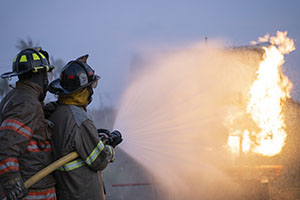
Witnesses to the Blaze
Valuable information can be obtained from civilian witnesses, the owner of the building, and emergency service personnel. The owner of the building can provide information about the contents and layout of the building.
First responders and others who saw the fire while it was burning can give details such as:
- The volume, color, height, and location of flames and smoke
- The direction the flames and smoke were moving.
- The status of fire alarms, security alarms and sprinklers
- Weather conditions
- The conditions of the structure
- Fire suppression techniques used
- Any disturbances made to the scene during fire-fighting efforts such as windows broken or forceful entry
Scanning the Scene
First responders and investigators should note the following as they scan the scene.
- Fire patterns
- Burn injuries
- Ignitable liquids
- Ignition or explosive devices such as lighters or matches
- Shoe prints or tire impressions
- Broken windows, doors, or other signs of forced entry
- Evidence of crimes in addition to possible arson (weapons, drugs, or drug lab equipment)

Investigators Evaluating the Scene
As the investigator evaluates the scene, the goal is to identify the origin and cause of the fire. Except in the most obvious cases, identifying the origin and cause of a fire requires specialized training and experience.
At this point, investigators need to remove evidence if it is in danger of being destroyed by the fire or the collapse of a damaged building.

Documenting the Scene
The scene is photographed and documented via notes and a detailed sketch. Photos should include
- The fire in progress (if available)
- The interior and exterior of the scene
- The area of origin and any ignition sources identified.

Investigators then continue to search for and secure evidence, being sure to store samples that may contain accelerants in airtight containers. Important evidence to collect includes:
- Ash, soot, and porous materials from around the scene, beginning at the suspected origin (or seat)
- Samples of various burned materials
- Vapors collected and identified using a vapor detector (sniffer)
- Ignition devices such as matches or electronic ignitors
Knowledge Check #1
Place the following steps of arson investigation in the correct order
- Search for and secure evidence
- Interview witnesses
- Secure the scene
- Scan the scene
- Photograph and document the scene
Answer: The correct order is
- Secure the scene
- Interview witnesses
- Scan the scene
- Photograph and document the scene
- Search for and secure evidence
Knowledge Check #2
What do you call the location where a fire started?
- origin
- ignition
- arson
- accelerant
Answer: a. origin
Identifying the Origin
There are numerous indicators that can be used to determine the origin or seat of the fire. However, many of these are often difficult to interpret once the fire has reached flashoverthe point at which the fire ignites all exposed combustible surfaces within the room . J.J. Lentini discusses the complexities of fire patterns in his article Fire Patterns and Their Interpretation.
- Extent of Damage
- The region in which a fire started will generally burn for a longer amount of time, thus will be an area with the worst damage.
- Fires tend to burn upwards, therefore the seat of the fire is likely to be found at a lower point of burn damage.
- However, this is not always reliable, as fires can spread downwards, particularly in the presence of certain fuel sources.

"Kyoto animation arson attack 2 20190721" by L26 is licensed under CC BY-SA 4.0. - Direction
- Fire effects on certain materials can indicate the direction of fire. As fire burns upwards and outwards, V-shaped smoke/burn patterns may be found on surfaces adjacent to the fire, with the end of the V pointing towards the point of ignition.
- However, ventilation can affect the path or shape of V-shaped patterns. Smoke deposits on object surfaces can suggest the direction from which the fire originated, and glass and plastics tend to melt in the direction of fire, thus distortion of such materials can act as directional indicators. Open Examples of Fire Patterns from InterFIRE to see other burn patterns on this site.
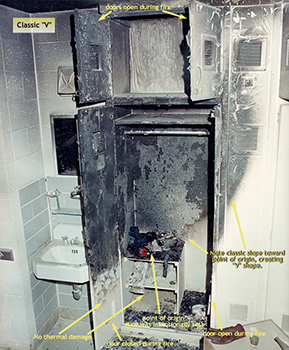
This image shows the classic "V" pattern. - Types of Damage
- Temperature and Growth
- The growth of the fire, whether fast or slow, and its heat can be suggested by fire damage at the scene.
- "Alligator skin" plaster suggests a very high temperature; the area with the smallest "scales" indicates the fire was hottest in that area, though the quality of the plaster and fire-fighting efforts can distort the usefulness of this.
- Intense charring is indicative of a slow, smoldering fire acting as the source.
- Glass
- Fire damage to glass can also suggest the heat of the fire. The rapid increase in temperature can cause clear breaks in the glass, whereas a very slow build-up of heat tends to cause the glass to soften rather than break.
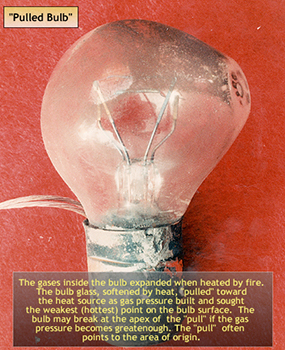
The damage to this bulb gives an indication of the origin of the fire. - Wood and Other Examples
- Examining the extent to which wooden structures have been charred can provide insight into the fire, as exposed wood chars at a rate related to the exposure time and amount of radiant heat.
- Open Examples of Thermal Effects on Materials from InterFIRE to how the heat from the fires can affect other materials, including carpet and linoleum flooring.
- Temperature and Growth
Can the Exact Origin Always Be Determined?
Due to the range of factors affecting the origin of a fire, it may not be possible to specify the exact point of ignition of a fire. Therefore, investigators generally define a confidence perimeter or radius of error. This is an extended section somewhere within which is the seat of the fire, with the most probable origin placed in the center of the circle. Generally, the radius of this circle will decrease as the investigator becomes more confident in establishing the origin.
Knowledge Check #3
Glass that is clearly broken in large pieces indicates a ___________________ may have occurred.
- rapid increase in temperature
- slow increase in temperature
Answer: a. rapid increase in temperature
Knowledge Check #4
V-shaped burn patterns can indicate the location of origin. The location of origin is in the direction of ________.
- the point of the V
- the opening of the V
Answer: a. the point of the V
Knowledge Check #5
Which of the following could cause a fire to burn downward?
- accelerants
- fire naturally burns down
- weather
- fire-fighting efforts
Answer: a. accelerants
Knowledge Check #6
Investigators identify an exact point of origin.
- True
- False
Answer: b. False
Determining the Cause of a Fire
After the seat is determined, investigators can work to determine the cause of the fire - accidental, natural, deliberate, or undetermined.
- Natural
- Natural fires are generally caused by weather, such as lightning strikes.
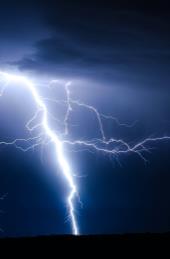
- Accidental
- Accidental fires involve no malicious intent and may be caused by an electrical malfunction or unattended candle or stove.
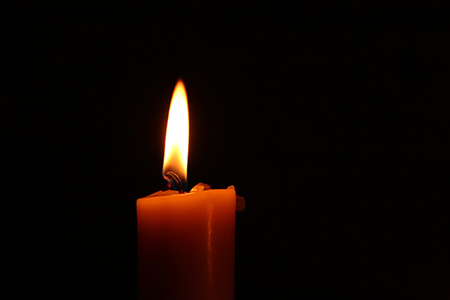
- Deliberate
- Deliberate fires are purposefully set in an act known as arson. There are some common signs of arson, including:
- Multiple sites of origin
- Ribbon shaped fire pattern, which indicates the fire was following the path of an accelerant
- Accelerant residue
- Burning concentrated to the floor (Heat and fire naturally rises unless there is a lot of accelerant on the floor.)
- Unburned combustible liquids
- Deliberate fires are purposefully set in an act known as arson. There are some common signs of arson, including:
Questioning Assumptions
Recently, scientists have begun to call into question some of the methods and assumptions made by previous fire experts, which was based on anecdotal experience and not true science.
Listen to or read this National Public Radio (NPR) segment Arson Forensics Sets Old Fire Myths Ablaze and see how the ATF's Fire Research lab is advancing fire science.
Knowledge Check #7
How did Lentini determine that the fire in Jacksonville, Fl may have not been intentionally set?
- burned a similar home and timed the fire
- timed the fire
- interviewed the suspect
- looked for gasoline and matches
Answer: a. burned a similar home and timed the fire
Knowledge Check #8
In the case of 16-year old Louis Taylor, what evidence was used against him?
- gasoline on his clothing
- surveillance video
- matches in his pocket
- soot on his shoes
Answer: c. matches in his pocket
Knowledge Check #9
How are researchers at the Fire Research Laboratory learning more about fire science?
- recreating fires and investigating their effects
- watching videos of previous fires
- using computer software to predict fire origin
- gathering experts to share their personal experiences
Answer: a. recreating fires and investigating their effects